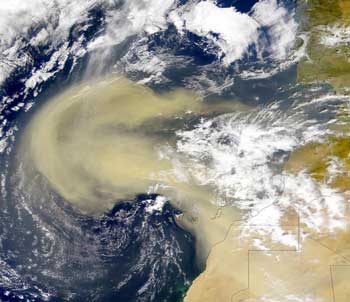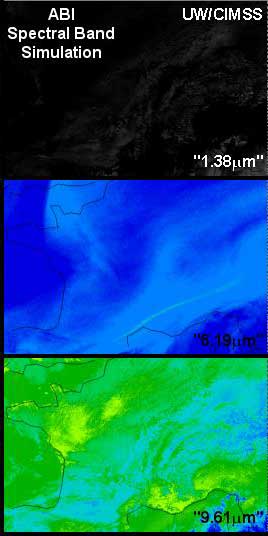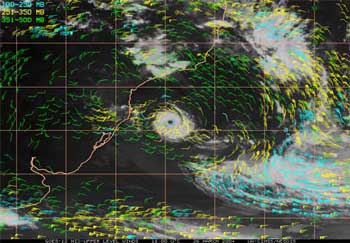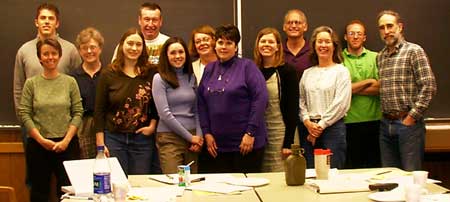Monthly News Summary – June 2004
Hurricane Season Starts in Research
African Air Connects to Hurricanes, by Alexis Johnson—
Meteorologists may soon be able to better understand and detect changes in hurricane intensity thanks to the work of Chris Velden, a CIMSS researcher, and Jason Dunion, a research meteorologist from the NOAA Cooperative Institute for Marine and Atmospheric Studies (CIMAS). Dunion and Velden found a connection between an African air mass, called the Saharan Air Layer (SAL), and Atlantic hurricane intensity changes. Their efforts are published in the March 2004 issue of the Bulletin of the American Meteorological Society (BAMS).
The SAL originates over the Saharan Desert and is characterized by dry air that is laden with dust. According to Velden, “This air mass frequently gets absorbed into the easterly trade wind belt and traverses a large portion of the tropical Atlantic Ocean during hurricane season.” Although CIMAS director, Joseph Prospero, and others first recognized the SAL over 30 years ago, the connection to Atlantic hurricane activity had never been investigated.
 |
Saharan dust plume off the western coast of Africa |
Dunion and Velden developed a technique that utilizes multispectral infrared information from the NOAA GOES satellites to detect and track the SAL as it moves west over the tropical Atlantic. The resulting imagery indicates that when the SAL engulfs tropical waves, tropical disturbances or hurricanes, the associated dry air, temperature inversion and vertical wind shear can hinder intensification. The technique will provide forecasters with an additional tool to monitor Atlantic tropical cyclones. It may also lead to a better understanding of the impact that the SAL can have on hurricane intensity changes in the tropical Atlantic.
Rare Event— Hurricane Catarina surprised meteorologists with a visit to the Brazilian coast in late March. Until then, it was said, no hurricane had occurred in the southern Atlantic Ocean. The topic was debated at a well-attended meeting at the American Meteorological Society’s Hurricane Conference held in Miami in May. According to Chris Velden, who leads the CIMSS Tropical Cyclones group, “The debate was whether the system in question was a classic tropical cyclone (TC), or some sort of hybrid. The satellite data suggests it was a TC, but there is still some disagreement.” Also at the meeting, Velden chaired a special session, “30 years of the Dvorak Technique.”
Isabel Loop Featured—WVEC-TV in Norfolk, VA will use satellite imagery of Hurricane Isabel in its annual hurricanes show to be aired June 9. CIMSS researcher Scott Bachmeier made several loops of this storm, showing its most unusual features.
NAUSICAÄ, France’s national sea-experience center in Boulogne-sur-Mer in northern France, has added the CIMSS Tropical Cyclones Web site to their database of links to “the most interesting Web sitesconcerning sea-related topics and marine activities.” The goal of NAUSICAÄ “is to incite the general public to discover the sea and to love it, while raising its awareness on the need for a better management of marine resources.”
Data and Imagery
SSEC’s Web site now includes as comprehensive a list of current research projects as is possible. Each current research project, whatever the field—atmospheric science, astrophysics, engineering, software design—is included. Each project listed includes a link to a short page describing that project and a link to that project’s Web site, if one exists. The SSEC Web group has tried to be as inclusive as possible, and would like to know if any current research project remains to be added. If you notice that a current research project is not included, please inform the SSEC Webmaster.
Data from Europe’s newest geostationary weather satellite, MET-8, were added to the Images and Datapage in early May. An informational page summarizes what each channel shows.
Engineering Feats
Global Change as Godzilla—Tony Wendricks, coordinator in SSEC’s Ice Coring and Drilling Service, consulted with Twentieth Century Fox props people for the movie, The Day After Tomorrow, based onThe Coming Global Superstorm by Art Bell and Whitley Strieber who both write about paranormal occurrences. In the movie, Dennis Quaid stars as a climatologist who witnesses “rapid climate change” when the ice shelf supporting him and his ice-coring crew suddenly crumbles. Wendricks said that the props crew seemed to want to get every aspect of ice drilling absolutely right. SSEC was not asked to consult on any scientific aspect of the film. NOAA and NASA, whose operations are used as backdrops in the movie (a situation room for numerical modeling, the international space station), were credited for providing only “photos.” The movie is exciting and entertaining and flouts the laws of physics.
Answering an email message from a mother of a child terrified by the movie, meteorologist Shelley Knuth of SSEC’s Antarctic Meteorological Research Center said, “Scientific data from the past (from ice cores) has shown that there may possibly have been a dramatic climate change that ended our last ice age. However, the abrupt climate change this data was referring to happened over the span of ten years or more, not within a few days as in the movie. Many of the incidents in the movie are physically unrealistic; for example, the freezing scenes, where the temperature drops 10 degrees per second, is completely bogus because there is a very simple rule of physics called ‘absolute zero,’ which is the temperature at which all matter is dead and unmoving, and if the circumstances in that movie were true, we would not only reach absolute zero in less than a minute, but we would also pass it up, which isn’t possible.” Although rapid climate change is possible (for example, the temperature cooled quickly around the globe when Krakatoa erupted in the 19th century), most of what the film shows can only be computer generated; it is impossible in real life. Remember, director Roland Emmerich also directed Independence Day. Emagazine.com notes that what’s really happening to our climate is even scarier than in this movie, because “the effects are subtle and incremental. Problems that are slow to develop and ongoing, like population growth, sprawl and air pollution, are a media blind spot.”
Field Experiments and Meetings
GOES Users Conference—The Daily Camera, a newspaper in Boulder, CO, covered a conference held there in May for users of future GOES. The article noted that a new generation of satellites will face new demands and, while budget constraints may demand that the same two instruments will fly on the next GOES, they will be much more powerful, according to Brig. Gen. David L. Johnson, assistant administrator for NOAA’s National Weather Service. CIMSS researchers Bormin Huang and Alok Ahuja were shown with their poster, which discussed how to compress the huge amount of data to be transmitted from a new weather and climate forecasting satellite. The Advanced Satellite Products Team (NOAA group stationed at SSEC), SSEC, and its CIMSS were well represented at the conference. Combined participation of federal and CIMSS personnel included 9 oral presentations and 23 posters on a wide range of topics. Wisconsin participants were also active during the break-out session and many discussions.
The program for the American Meteorological Society’s 13th Conference on Satellite Meteorology and Oceanography to be held September 20–23 in Norfolk, VA has been posted on-line. The special theme for the conference is “Next Generation Environmental Sensors and Emerging Applications in Satellite Meteorology and Oceanography.” Program chairs Elaine Prins (NOAA, working with SSEC) and Chris Velden (CIMSS) said that more than 200 abstracts were submitted in six topic areas: 1) Climatology and Long-Term Satellite Studies; 2) Environmental Applications; 3) Operational Products; 4) Retrievals and Cloud Products; 5) Data Assimilation; and 6) New and Future Sensors and Applications.
Planets
Observing Venus—In early May, planetary scientist Sanjay Limaye called for astronomers, both professional and amateur, to “make coordinated observations of Venus in the near infrared.” From his backyard in Bruz, France, Christophe Pellier answered the call with the “first-ever amateur image of the surface of Venus.” Their collaboration is featured in Sky and Telescope magazine for June 2004. Limaye notes that Pellier “provided the first long-term coverage of [Venus’s] night side.” Until now, no one has done that. Limaye himself observed Venus with a telescope on a mountain in India. Astronomers in Colorado, Sweden and India did the same.
Weather Experts
Wisconsin weather-records maven Scott Lindstrom was interviewed by David Medaris for Isthmus,Madison’s alternative newspaper (June 4). The wide-ranging article goes into some depth on Lindstrom’s study of climate data. Like most meteorologists, his interest in weather forecasting was piqued by a significant event, in Lindstrom’s case, a bad forecast—during his school years, a forecast called for enough snow to close schools. He woke disappointed, without having done his homework. He decided then to learn enough about the weather to do his own forecasts. Medaris notes that the data Lindstrom collects is found on theWeb; Lindstrom finds the patterns in it. He recently noted that “Madison had the wettest calendar month ever in May—10.84″.” Lindstrom works for SSEC as an information technologist, comparing precipitable water estimates from satellites and developing software, with more than one hundred other technical experts, each unique in his and her own way, doing their own bits to make weather forecasts better.
Weather Research
Simulating Satellite Data—SSEC and its Cooperative Institute for Meteorological Satellite Studies (CIMSS) have a long history of simulating data from proposed satellite instruments. They have begun to use Meteosat-8, MODerate-resolution Imaging Spectroradiometer (MODIS), and Atmospheric InfraRed Sounder (AIRS) data to spectrally simulate the bands on the future Geostationary Operational Environmental Satellite (GOES)-R Imager. The GOES-R Advanced Baseline Imager (ABI) will have sixteen spectral bands, two visible, four near-infrared, and ten infrared, with spatial resolutions ranging from 500m to 2km. Mat Gunshor (SSEC’s CIMSS) and Tim Schmit (NOAA at SSEC) are researchers primarily involved in the research.
 |
These are just three spectral bands proposed for the GOES-R Advanced Baseline Imager. Click on the image for all of them. |
Satellite Observations Increase for Navy—Recently, the U.S. Air Force Weather Agency (AFWA) improved their weather forecast model by including satellite wind measurements using an algorithm developed and provided by UW–Madison’s SSEC. The automated algorithm, called Feature Track Winds, allows the routine production of wind vectors from multiple satellite platforms, and has greatly increased the volume of data available to be assimilated into their weather forecast models. As a result, the quality of the model output improved considerably. AFWA Staff Sargeant Carl Schuett added that “the model error in winds measurement dropped by 2.5m per second.”
Papers
Tim Schmit and Bob Aune (both in NOAA’s Advanced Satellite Products Branch at SSEC) participated in the National Highway Visibility Conference held in Madison, WI , May 17–18, 2004. They presented “Future Geostationary Observations for the Improved Detection and Short Range Prediction of Fog.”
“Daytime cloud overlap detection from AVHRR and VIIRS,” by M. Pavolonis (SSEC’s CIMSS) and A. Heidinger (NOAA, at SSEC), was published in the May issue of the Journal of Applied Meteorology. The paper describes two automated algorithms for detecting cloud overlap using daytime satellite imagery.
“Sea ice surface temperature product from the Moderate Resolution Imaging Spectroradiometer (MODIS)” was published in IEEE Transactions on Geoscience and Remote Sensing (2004, Vol. 42, No. 5). The authors include D. Hall (NASA’s Goddard Space Flight Center (GSFC)), Jeff Key (NOAA, at SSEC), and others at GSFC. The paper introduces the MODIS sea ice temperature product, the retrieval methodology, and validation over the Arctic and Antarctic. NOAA’s Advanced Satellite Products Team at SSEC’s Cooperative Institute for Meteorological Satellite Studies developed the ice surface temperature algorithm. This product extends the use of existing sea surface temperature products to the frozen ocean. The algorithm is relevant to NOAA’s future Visible/Infrared Imager and Radiometer Suite (VIIRS) instrument. A figure from the paper was used on the journal cover.
A paper on nighttime cloud detection in the polar regions using the Moderate Resolution Imaging Spectroradiometer (MODIS) was accepted for publication in the Remote Sensing of Environment journal. “Nighttime polar cloud detection with MODIS,” by Y. Liu (CIMSS), J. Key, R. Frey (CIMSS), S. Ackerman (CIMSS), and W.P. Menzel, presents new cloud detection tests that utilize water vapor and carbon dioxide bands.
These abstracts have been submitted to the SPIE’s Fourth International Asia-Pacific Environmental Remote Sensing Symposium, Applications with Weather Satellites II, to be held in November in Honolulu, Hawaii.
- “Vertical resolution study on the GOES-R Hyperspectral Environmental Suite (HES),” by Jun Li, Fang Wang, Timothy J. Schmit, W. Paul Menzel, and James Gurka.
- “Cloud classification products derived from operational imagers” and “The global distribution of cloud type from operational polar-orbiting imagers: The past and present (AVHRR) and the future (VIIRS)” by Michael J. Pavolonis (CIMSS) and Andrew K. Heidinger (NOAA, at SSEC).
Education, Outreach
Suomi High School scholarship awards were noted in Wisconsin Week, the official campus newspaper, on May 12. Four Wisconsin high school seniors who will pursue an undergraduate degree in the physical sciences received the $1000 scholarship. This year’s scholarship committee of K. Strabala (SSEC), S. Bachmeier (SSEC), and G. Wade (NOAA) evaluated and discussed 16 applications and recommended 5 applicants for final consideration by CIMSS staff (Director S. Ackerman, L. Avila, and T. Achtor) who selected 4 applicants for awards: Katherine Behrendt of Waukesha, who intends to major in materials engineering at UW–Madison; Jacob Cychosz of Waunakee, astronomy/physics at UW–Madison; Elise Gorchels of Fitchburg, astronomy at UW–Madison or UW–Milwaukee; and Victoria Vasys of Madison, electrical engineering at UW–Madison.
The Wisconsin Weather Stories project was supported by a Baldwin Grant this past year. Anne Pryor, Wisconsin Arts Board’s Folk Arts Education Coordinator and a project principal investigator, will discuss this engaging project at Space Place this Tuesday, June 8, at 7 p.m. The lecture is free and open to the public; Space Place is at 1605 S. Park Street.
Participants in Wisconsin Weather Stories project, at their final, summary workshop: Top row—Kris Karnauskas, Mary Kornely, Russ Bailey, Karyl Rosenberg, Steve Ackerman, Louie Holwerk, Jim Leary. Bottom row: Margaret Mooney, Claire Schmidt, Holly DeRose, Mary Jo Fuhry, Jamie Yuenger, Anne Pryor
Also of Note
Quill, a magazine for professional journalists, features the work of students in UW–Madison’s School of Journalism (May 2004). This year, they reactivated the school’s chapter, long defunct, of the Society of Professional Journalists, and “set it on course to become one of the organization’s most active.” Among the energetic group is Alexis Johnson, science writing intern at SSEC; she is the chapter’s Webmaster.
Updated UV Index—The Private Sector Listserve of the American Meteorological Society recently announced that the U.S. Environmental Protection Agency and NOAA’s National Weather Service have updated the UV Index to be consistent with international guidelines developed by the World Health Organization. The UV Index is a daily forecast of the expected risk of overexposure to the sun. The revised Index features a new color scheme and modified sun exposure categories.
New IMAX Film—The Milwaukee Public Museum will launch a new IMAX® film called Forces of Nature
on June 18, showing through December 16. “Featuring the beauty and dangers of weather, the film will bring home the importance of weather safety.” Contact Marketing Manager Katie Newcomb for times and ticket information. The Humphrey IMAX Dome Theater is the only IMAX theater in Wisconsin.


